9 Types of Hummingbirds in Nevada (With Pictures)
Last Updated on
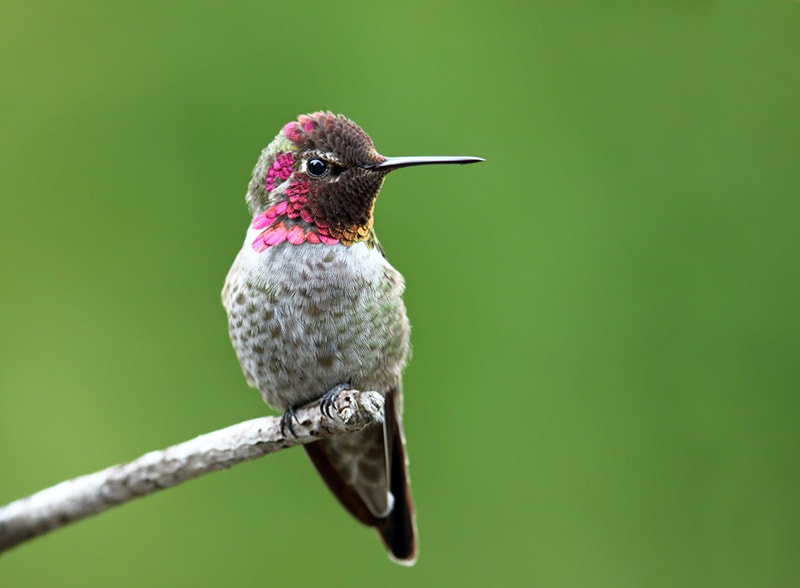
Hummingbirds add eccentric, bright colors to Nevada’s environment. These small, fast-moving birds are one of the state’s most popular breeds, often swooping in dramatic patterns in the air. On your visit to Nevada’s nearest garden or roadside, you will see these pink, purple, green, red, and black birds flying here and there.
Most hummingbird species are pretty hard to differentiate from each other. However, the major difference is the color of streaking on their throats and faces. If you live in a warmer climate, such as Central America or Mexico, you’re likely to witness many hummingbird species throughout the year, especially in summer.
Of 27 hummingbird species found in the US, Nevada is home to nine of them1. Let’s learn the distinguishing features of each to spot them the next time easily!

The 9 Types of Hummingbirds in Nevada
1. Anna’s Hummingbird (Calypte anna)

| Scientific Name: | Calypte anna |
| Size: | 3.9 inches |
| Weight: | 0.1 to 0.2 ounces |
| Wingspan: | 4.7 inches |
Anna’s Hummingbirds are widespread along the Pacific Coast and some parts of the US, including Nevada. These birds live in these regions all year but travel inland when their breeding season starts. Some of Anna’s Hummingbirds also fly to Mexico in the non-breeding season.
You can spot these birds by their greenish-gray bodies. They have iridescent feathers, with males having reddish-pink hues in their heads and chins.
If you try to witness Anna’s Hummingbirds in their breeding season, you might see the males swooping down to a maximum of 135 feet. When doing this, they move their tail feathers to make a buzzing sound to attract females.
Anna’s Hummingbirds love to visit feeders without fearing humans. You will find them feeding on the tubular flowers, picking up insects, and eating food from feeders. So, if you want to see these birds, offer them enough food and water in your backyard.
2. Rufous Hummingbird (Selasphorus rufus)
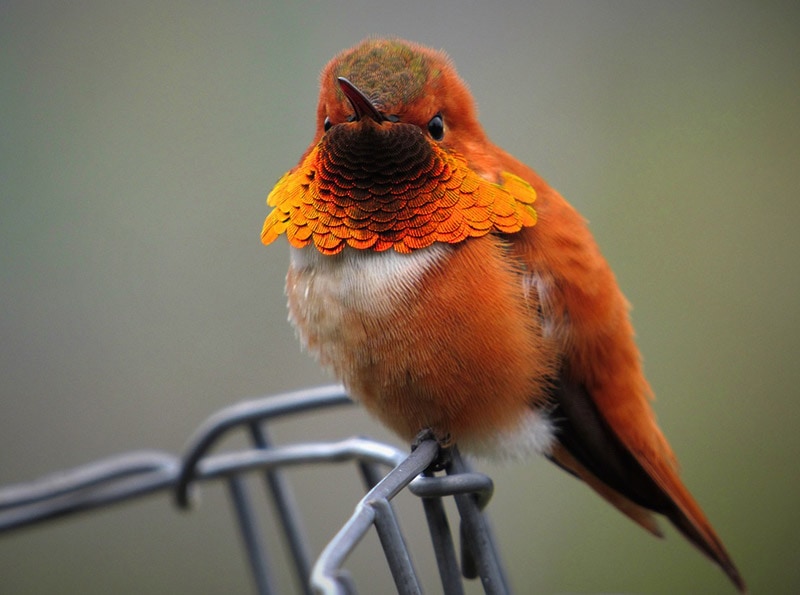
| Scientific Name: | Selasphorus rufus |
| Size: | 2.8 to 3.5 inches |
| Weight: | 0.1 to 0.2 ounces |
| Wingspan: | 4.3 inches |
Rufous Hummingbirds are another abundant species in Nevada. You can witness these birds throughout the year, but they move to their west coast’s breeding grounds from April to July to spend the entire spring there.
These birds have red streaks, which shine like burning coal when sunlight falls on them. Females have green streaks on their tails and flanks and orange spots on their throats. Males, on the other hand, have bright red throats and backs.
Rufous Hummingbirds do not like intruders at all. They defend their area fiercely and do not get tired of chasing predators that come close to their territory. This hummingbird species is the bravest since they don’t fear chasing after larger birds and even humans. So, stay several feet away when you spot these hummingbirds.
Rufous hummingbirds prefer living in forests, parks, and backyards since these places have abundant food sources. You will find them feeding tubular flowers’ sap, insects, and food from feeders.
3. Black-chinned Hummingbird (Archilochus alexandri)

| Scientific Name: | Archilochus alexandri |
| Size: | 3.5 inches |
| Weight: | 0.1 to 0.2 ounces |
| Wingspan: | 4.3 inches |
Be prepared to witness some blackbirds in Nevada throughout the year. Black-chinned Hummingbirds are highly adaptable species that can live anywhere that is safe. Many experts call them “generalists” because of this. These birds may nest and fly in urban shrubs, forests, and even deserts.
The Black-chinned Hummingbirds’ breeding season begins in spring when they build nests. This continues from April to May and then again starts in July. During the winter, these birds travel to the Gulf Coast. So, make sure you look for these hummingbirds at the right time.
You can quickly identify a Black-chinned Hummingbird from the bright purple base in its black throat. Females have pale throats and white tips on the tail feathers. Both genders have black bills, making this species a more subdued one rather than bright-colored.
Black-chinned Hummingbirds like feeding from feeders. So, attract them to your yard by adding their favorite foods to the feeders, such as insects, tree tobacco, desert ocotillo, and scarlet larkspur. They also love the flower sap. You can also install trees in your yard since these birds like sitting on treetops to have a broad view of an area.
Remember, these hummingbirds can get pretty aggressive when someone tries to enter their territory. So, install feeders at significant distances to avoid any fights.
4. Broad-tailed Hummingbird (Selasphorus platycercus)
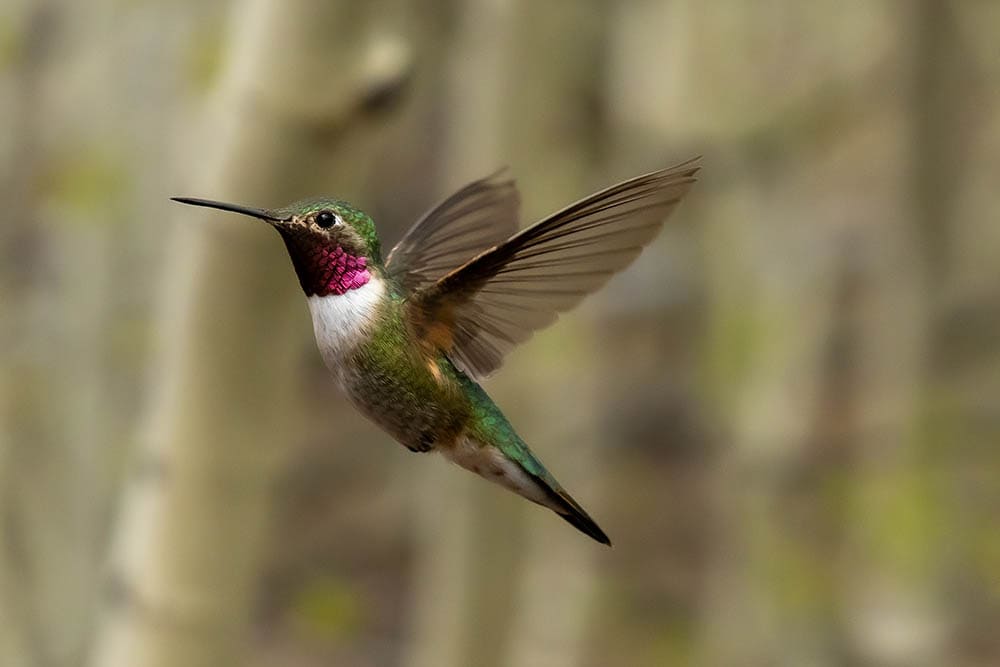
| Scientific Name: | Selasphorus platycercus |
| Size: | 3.3 to 3.8 inches |
| Weight: | 0.13 ounces |
| Wingspan: | 5.25 inches |
Having a striking resemblance to Ruby-throated Hummingbirds, the Broad-tailed Hummingbirds are common birds in Nevada all year. This species prefers living in high mountain areas with meadows. Both males and females have broad tails and a beautiful combination of green, red, and white.
These birds typically live in areas with warm days and cold nights. Because of this, they have adjusted their heart rate and temperature according to the outside weather—lower at night and higher during the day.
They show similar aggression as other hummingbird species when someone tries to enter their area. You’ll find them fiercely chasing intruders, no matter how big they are.
You can attract Broad-tailed Hummingbirds to your backyard by adding pendulous flowers and their favorite foods to the feeder. They also love small insects.
5. Costa’s Hummingbird (Calypte costae)

| Scientific Name: | Calypte costae |
| Size: | 3.5 inches |
| Weight: | 0.1 ounces |
| Wingspan: | 4.3 inches |
Costa’s Hummingbirds are compact birds with hunched bodies. These birds are the inhabitants of the deserts in the western part of the US. You may also find them in Nevada and Utah and sometimes in Florida and Alaska during their migration period.
You can identify Costa’s Hummingbirds by their eccentric purple crown and neck. Their backs and sides are green.
To spot these birds, you have to look at the right place. These birds usually breed in the interior US but prefer staying on the coast throughout the year. When their non-breeding season starts, some birds may travel to coastal Mexico.
Attracting Costa’s Hummingbirds to your yard might be difficult. These birds are pretty shy, so they avoid coming close to humans and visiting feeders, especially if they see bigger and more aggressive birds there.
6. Calliope Hummingbird (Selasphorus calliope)
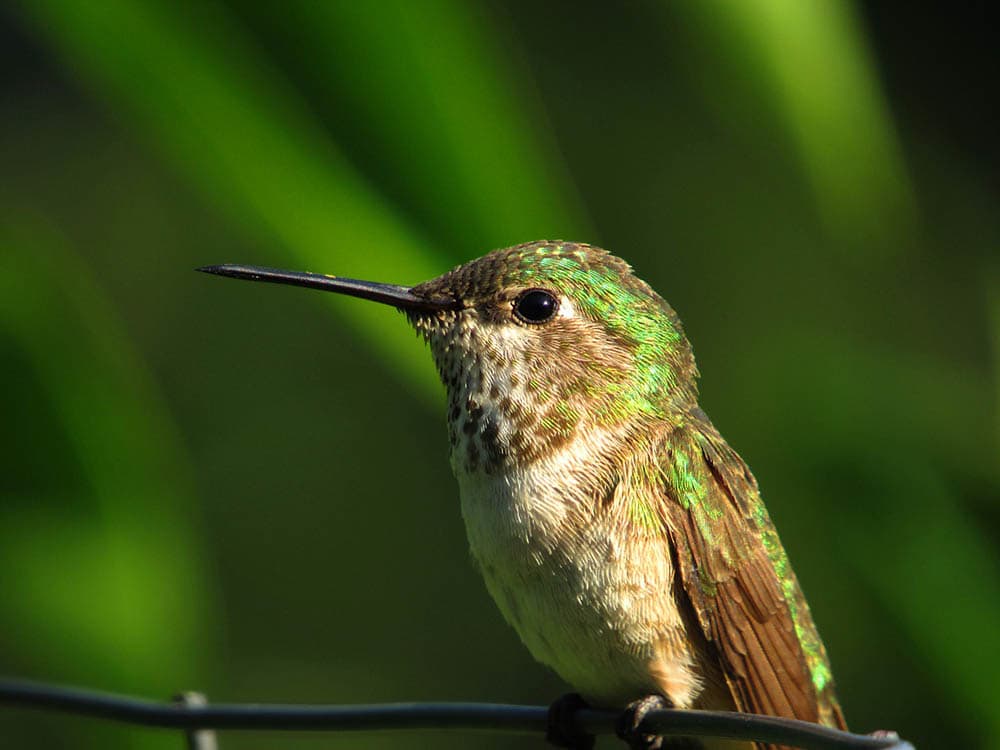
| Scientific Name: | Selasphorus calliope |
| Size: | 2.8 to 3.9 inches |
| Weight: | 0.07 to 0.1 ounces |
| Wingspan: | 4.3 inches |
Calliope Hummingbirds are native species in Nevada, the Pacific Northwest, and Canada. They spend their breeding season in Montana, Wyoming, Washington, and Utah. During their non-breeding season, they move to Mexico.
You can identify the male Calliope Hummingbirds from their magenta throats. Both males and females have green backs. If you visit the habitats of Calliope Hummingbirds from April to June, you may witness the males flying in a u-shape while producing a buzzing sound from their tails.
Calliope Hummingbirds love visiting feeders. You can include tubular flowers in your backyard to provide these birds with sap, but they are fond of nectar that sapsuckers leave on trees. They also love to feed on spiders and insects.
However, if other hummingbird species are already at the feeder, these birds may become shy. But they’re not afraid of other birds and have been seen chasing red-tailed hawks.
7. Broad-billed Hummingbird (Cynanthus latirostris)

| Scientific Name: | Cynanthus latirostris |
| Size: | 3.5 inches |
| Weight: | 0.1 ounce |
| Wingspan: | 4.3 inches |
The Broad-billed Hummingbirds are residents of Nevada and Mexico, where they stay throughout the year. The best time to witness these birds in Nevada is the winter because they travel to the North during their breeding season. In Nevada, you will only witness the magicus sub-species since only one out of five Broad-billed Hummingbirds live in the US.
You can identify these birds from their straight and long bills. Their tales also have a notch in the center, distinguishing them from other hummingbird species. Look for the vivid green birds with blue throats and red bills. These are male Broad-billed Hummingbirds.
Broad-billed Hummingbirds nest in mountainous regions. They move to higher elevations after raising their children. During courtship, the males fly like a swinging watch to attract the females. Like other hummingbirds, they also eat flower nectar and insects.
8. Allen’s Hummingbird (Selasphorus sasin)
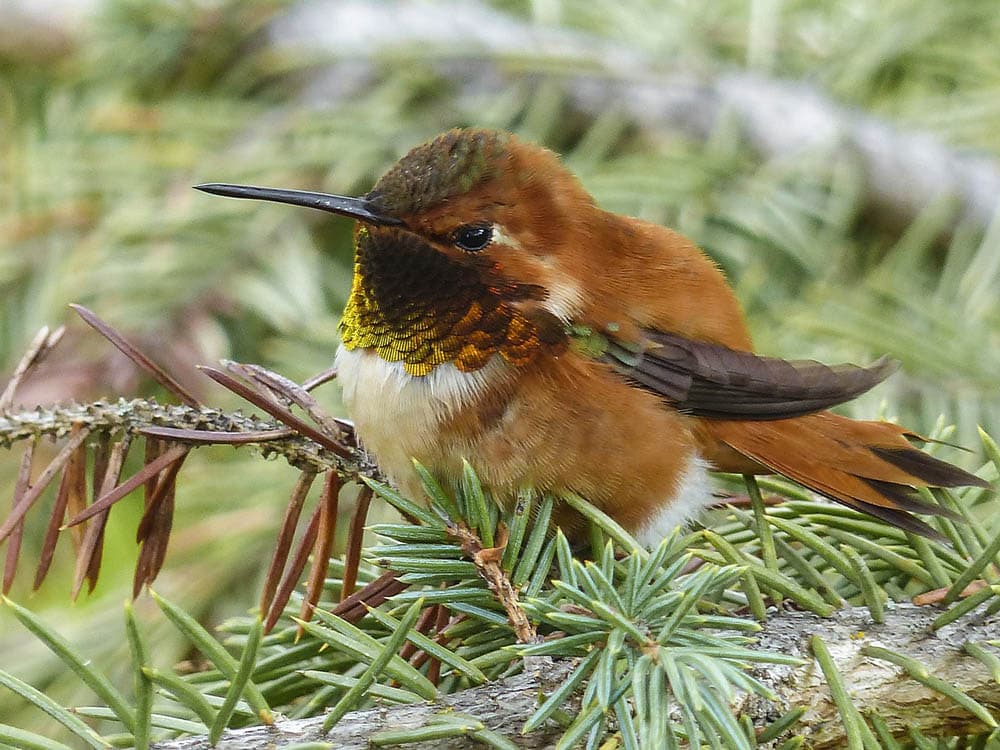
| Scientific Name: | Selasphorus sasin |
| Size: | 3.5 inches |
| Weight: | 0.1 ounce |
| Wingspan: | 4.3 inches |
Allen’s Hummingbirds are noticeable birds along the coast of Nevada during the winter. They reside in the scrub of Nevada’s coastal regions, spreading to Southern Oregon.
These bright-colored hummingbirds love to travel! They fly to Southern Mexico from their breeding grounds and stay there the entire non-breeding season. Sometimes, they also travel along the Gulf Coast to as far as Florida.
Fortunately, you will find these birds in Southern Nevada throughout the year. However, the best time to see these hummingbirds is from October to June. During this period, the non-migratory Allen’s Hummingbirds nest in Nevada.
Look for petite birds with copper-orange throats and green backs. Visit your nearest garden or forest to see these birds snatching insects from the air and sucking nectar from flowers. They also visit feeders.
9. Rivoli’s Hummingbird (Eugenes fulgens)

| Scientific Name: | Eugenes fulgens |
| Size: | 4.3 to 5.5 inches |
| Weight: | 0.2 to 0.35 ounces |
| Wingspan: | 7.1 inches |
Rivoli’s Hummingbirds are rare in Nevada. But if you visit the state during their breeding season in the summer, you may find these birds in Nevada, Arizona, and Texas. They fly from Mexico to these states for breeding grounds. They’re primarily seen near San Diego and the northern coastal regions of Nevada.
Rivoli’s are relatively larger hummingbirds with a unique color combination. No wonder they’re famous as “magnificent hummingbirds.”
The male has vibrant green streaks on its black body with an emerald-green throat and a violet crown. Females, on the other hand, are less vivid with gray and green colors. Remember, these hummingbirds like living in higher elevations, so you’re less likely to see them near the coast.
Rivoli’s Hummingbirds are hardy travelers. If it’s your lucky day, you may see these birds in unusual places in Nevada.

How to Attract Hummingbirds to Your Yard
There are nine hummingbird species reported in Nevada. Luckily, most of them are natives of the state, so you can easily spot them. The good thing is that these birds love visiting feeders and are not afraid of humans.
Follow the tips below to attract your favorite hummingbird species to your backyard:
Install a Feeder
Hummingbirds love to travel, so they need food during their flights. Installing bird feeders in your yard gives these birds a reason to stop by and energize themselves. Make sure to install the feeder at a little perch. This way, you can easily see these birds feeding.
While some people prefer installing a red feeder to attract hummingbirds, that does not always work. Honestly speaking, birds only care about their favorite feeds in the feeders, not their colors.
You must take your feeders away in the winter, as they may invite tropical birds to them. Since some hummingbirds are shy or afraid of other birds, they may avoid coming to your feeders.

Keep the Feeders Clean
Regularly clean the feeders to prevent mold formation. You can use the soap and hot water mixture to wash the feeder. It’s better to do this every day, but thrice a week is also fine. However, in winter, you can clean the feeders once or twice a week.
Use Nectar
Hummingbirds like to feed on the nectar or sap of tubular flowers. You can easily buy readymade nectar from the store and put them in your yard to attract these birds.
Since hummingbirds don’t care about the color, you don’t have to dye the nectar. Clear nectar will also work. Also, ensure to change the nectar frequently. Hummingbirds love fresh nectar!

Plant Their Favorite Trees
Some Hummingbird species like to sit on treetops and other higher elevations, such as wire and telephone cables. So, to attract these birds, you can plant hummingbirds’ favorite trees, such as Honeysuckle, Fuschia, Firebush, Columbine, Trumpet, and Powderpuff plants.

Conclusion
Nevada hosts nine hummingbird species all year. While most are seen throughout the year, some are rare and only spotted by lucky birdwatchers. These species include Allen’s and Rivoli’s Hummingbirds.
Hummingbirds are generally small and bright-colored birds. But the variations can be surprising. For example, female Black-chinned Hummingbirds are more subdued than other species, and Rivoli’s are larger than the rest.
Remember the distinctive features of each hummingbird species the next time you try to birdwatch them. Also, look for them at the right time of the year!
Featured Image Credit: Birdiegal, Shutterstock
Table of Contents
- The 9 Types of Hummingbirds in Nevada
- 1. Anna’s Hummingbird (Calypte anna)
- 2. Rufous Hummingbird (Selasphorus rufus)
- 3. Black-chinned Hummingbird (Archilochus alexandri)
- 4. Broad-tailed Hummingbird (Selasphorus platycercus)
- 5. Costa’s Hummingbird (Calypte costae)
- 6. Calliope Hummingbird (Selasphorus calliope)
- 7. Broad-billed Hummingbird (Cynanthus latirostris)
- 8. Allen’s Hummingbird (Selasphorus sasin)
- 9. Rivoli’s Hummingbird (Eugenes fulgens)
- How to Attract Hummingbirds to Your Yard
- Plant Their Favorite Trees
- Conclusion
About the Author Jeff Weishaupt
Jeff is a tech professional by day, writer, and amateur photographer by night. He's had the privilege of leading software teams for startups to the Fortune 100 over the past two decades. He currently works in the data privacy space. Jeff's amateur photography interests started in 2008 when he got his first DSLR camera, the Canon Rebel. Since then, he's taken tens of thousands of photos. His favorite handheld camera these days is his Google Pixel 6 XL. He loves taking photos of nature and his kids. In 2016, he bought his first drone, the Mavic Pro. Taking photos from the air is an amazing perspective, and he loves to take his drone while traveling.
Related Articles:
Monocular vs Telescope: Differences Explained (With Pictures)
10 Types of Hummingbirds in Arkansas (With Pictures)
8 Types of Hummingbirds in Nebraska (With Pictures)
5 Types of Hummingbirds in Idaho (With Pictures)
3 Types of Hummingbirds in Mississippi (With Pictures)
8 Types of Hummingbirds in Kansas (With Pictures)
5 Types of Hummingbirds in West Virginia (With Pictures)
5 Types of Hummingbirds in Ohio (With Pictures)
